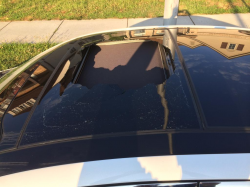
— A Kia exploding sunroof lawsuit has failed class action certification after a Kia owner claimed the sunroofs contained defects that caused the glass to shatter.
The plaintiff who sued says he was driving his 2012 Kia Optima on a highway in 2015 when he suddenly heard a loud noise as his panoramic sunroof exploded and sent glass into his Kia.
The glass allegedly fell onto him and his wife, causing small cuts and glass splinters on their arms and legs.
According to the plaintiff, the panoramic sunroofs have common design defects that cause the sunroofs to shatter, making these vehicles too dangerous to drive.
- 2011-2015 Kia Sorento
- 2011-2015 Kia Sportage
- 2011-2015 Kia Optima (including hybrid)
- 2014-2015 Kia Cadenza
The proposed class action was filed on behalf of all persons and entities who purchased or leased an affected Kia vehicle in Ohio.
Kia uses tempered glass for its panoramic sunoofs which Kia says, “is the material of choice for about 90% of sunroofs industry-wide.”
Tempered glass is installed because of its strength and reduced risk of injuries due to how the glass is designed to fragment immediately into small pieces which are less likely to cause serious injuries.
Kia alleges it has performed at least six investigations into the sunroofs and couldn't find any defects. In addition, the judge says the National Highway Traffic Safety Administration (NHTSA) has been investigating Kia Sorento sunroofs for six years and has still not announced a finding of defects.
Judge Matthew W. McFarland says while it may appear that Kia’s spontaneously shattering sunroofs are a problem, "the question presented to the Court is much narrower: whether a class-action lawsuit is the most judicially efficient avenue to resolving that problem?"
The plaintiff insists the lawsuit should be certified as a class action because "classwide proof can speak to the main issues in this case: that there’s a defect, that it’s dangerous, and that Kia continued to manufacture and sell the vehicles while concealing the danger from drivers.”
According to the judge, the plaintiff's negligent design claim requires proof that "Kia breached its duty to design against reasonably foreseeable hazards." Additionally, the implied warranty claim requires proof that "Kia manufactured and sold Class Vehicles with a defect.”
“The flaw in Kia’s design is thus well-understood.” - Kia lawsuit plaintiff
But the judge ruled, "it is not well-understood."
"If it was, NHTSA’s six-year investigation would have concluded by now and Kondash [plaintiff] would not have needed two experts to testify as to what, exactly, the 'design defect' is and how it is common amongst all 22 model-year Class Vehicles." - Judge McFarland
The judge found serious problems with the testimony of an expert for the plaintiff.
“[F]or some time,” the Sixth Circuit has recognized that expert testimony prepared solely for purposes of litigation, as opposed to testimony flowing naturally from an expert's line of scientific research or technical work, should be viewed with some caution.”
According to the judge, the expert testimony against Kia was not only “prepared solely for purposes of litigation, but there is also evidence that some of it may have been prepared solely by the litigants."
The plaintiff's expert claims the Kia sunroof failure rate is 2.14%, but the judge ruled the rate isn't reliable, which cancels out the argument there is a class-wide sunroof defect.
Kia argues the failure rate does not actually calculate “failures” because the expert counts replacement parts sold, not incidents.
The judge found the expert report shows that multiple replacement parts may be used in any one sunroof repair, especially since the vehicles “each have either two or three tempered glass panels.” Yet under the calculation offered by the expert, every replaced pane of glass would count as a separate “failure.”
This means if Kia had to order two or three glass panels for only one incident in one vehicle, the expert would count each panel that was ordered, which doubles or triples the number of sunroof failures.
The judge found the expert also counts every time a replacement part was sold regardless of the reasons why, even though parts could be ordered for many reasons (car crash, leaking, wind or the mechanism that opens the sunroof).
This caused the judge to rule the expert opinion has no factual basis and is purely speculative.
"In sum, without the expert testimony of Hannemann and Read [the experts], there is no evidence of a class-wide defect. And without evidence of a class-wide defect, there is nothing that ties the class together in order to satisfy predominance." - Judge McFarland
The Kia exploding sunroof lawsuit was filed in the U.S. District Court for the Southern District of Ohio: Kondash, et al., Kia Motors America, Inc., et al.
The plaintiff is represented by the Gibbs Law Group, Berger Montague, Merriman Legal, and Greg Coleman Law.




